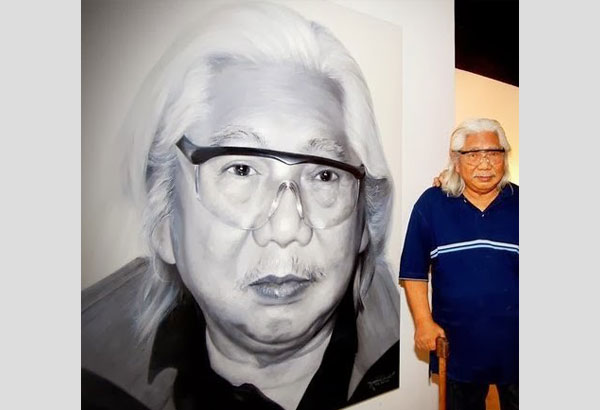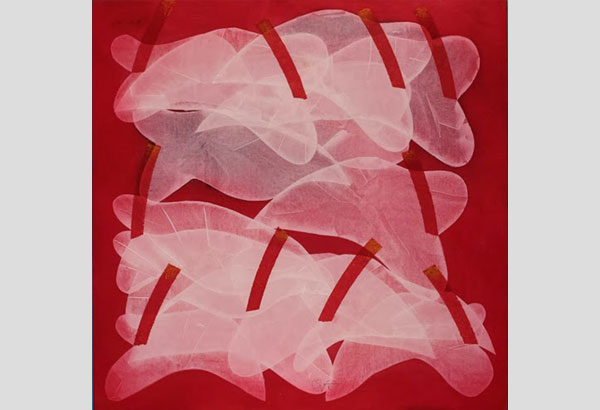Romulo Olazo: An achievement in luminous, ennobling forms

For his startling, luminous shapes — chiefly the “Diaphanous” and “Permutation” series —that comprise his life’s work, Romulo Olazo remained a fierce defender of abstraction in a field dominated by realist works for more than half a century, creating almost infinite variations of his style that to this day is unmatched for its lyrical power, masterful subtlety and dazzling treatment of color and light. It is this body of work that will be the enduring legacy of the artist who passed away last Tuesday, Aug. 18. He was 81 years old.
“He was really the foremost abstractionist and he was able to merge the techniques of printmaking and oil painting,” said John Valenzuela, who runs Paseo Gallery, which organized exhibitions for Olazo. He echoes the sentiment of Alice Guillermo in the book Romulo Olazo (which Valenzuela published) who wrote: “The Diaphanous and Permutation Series launched Filipino artist Romulo Olazo into an abstractionist whose name resonates not only in our country but also all over the world.”
Such esteemed regard for Olazo’s artistry is matched by how others regard him as the resident good guy in the art world. “Sobrang bait niyan,” says Vita Sarenas of Finale Art File. “Sometimes, he was just too good to a lot of people. He smiled often. You won’t hear anything negative from him kahit na that’s how the art scene is.”

Noted Romulo Olazo, beside his portrait, in one of the exhibitions of Paseo Gallery
Vita says that she owes a lot to Olazo who was one of the four artists featured in “Four Masters: Four Worlds,” the first exhibition which Finale organized in 1983 at Sunvar Plaza in Makati City. The three other masters were Ang Kiukok, Cesar Legaspi and Malang. The exhibition became an annual event and lasted for decade, a year before Legaspi died. “That really opened Finale,” Vita says. She remembers fondly the dining sessions she had with Olazo, together with Ang Kiukok and Agustin Goy, during the ‘80s at Sun Moon Restaurant in Greenhills.
Olazo, known to family and friends as “Ola” or “Mang Ola,” was born on July 21, 1934 in Balayan, Batangas. He took up Fine Arts at the University of Santo Tomas (UST) under Diosdado Lorenzo and Victorio Edades, who were the prime movers of Modernism in the country. He began with printmaking and then moved on to oil painting, which would eventually become the artist’s preferred medium.
Though he joined the advertising industry after college, he worked as though he were a full-time artist. Soon, awards came his way: as one of the first recipients of the Thirteen Artists Award of the Cultural Center of the Philippines (CCP) in 1972, the Philippine representative to the XII Sao Paolo Biennial in 1973 and an honorable mention in the 11th International Biennial Exhibition of Prints in Tokyo in 1979.

While his “Diaphanous” series may not refer to actual forms in the natural world, here, it reflects the shape and silhouette of anthuriums. Photos courtesy of Paseo Gallery
It wasn’t long before Olazo became a family man, marrying Patricia Tria and having three children: Noelle Nieves, Jonathan Emmanuel and Joanne Jill. Olazo credits his wife Pat for his success. “Magaling kasi ang misis ko,” he told Tara Sering of The Philippine STAR. “She takes care of everything.” His son Jonathan would eventually follow his father’s footsteps and become an artist, receiving the Thirteen Artists Award as well.
“Although I’m not a son, I saw how he cared for his children and his family,” says John of Paseo Gallery. “He was really a very devoted family man. He would spend a lot of time with his family and he would normally joke with his family. Although outside you’d see him as very serious, but when it comes to his children you would see that he would horse around. That’s my best memory of him as a person.”
On Nov. 7 last year, John helped Olazo reveal “Diaphanous B-CCXXXV,” at the ArtistSpace of Ayala Museum. Measuring six-feet-high and 20 feet across, it is the biggest “Diaphanous” work to date. “He was very excited because it was his biggest work and he was very happy to have completed it at such a late age,” John says. “It was not an ordinary exhibit because it was non-selling.”
In his exhibition note, art critic Cid Reyes states that the “Diaphanous” series “are a landmark and, by now, canonical works in contemporary Philippine art, sustained through the decades (amazingly close to half a century), a resplendent example of the inexhaustibility of his chosen abstract format, and by its varying size, a chameleon quality to surrender to an intimate space, as well as projecting a theatrical and operatic presence…”
Though wheelchair-bound and wearing a pacemaker, Olazo stayed late into the night, greeting well-wishers and accommodating their requests for a photo-op against what would turn out to be his swan song, a soaring conclusion to a life-long devotion to art and its miraculous and ennobling forms.



















